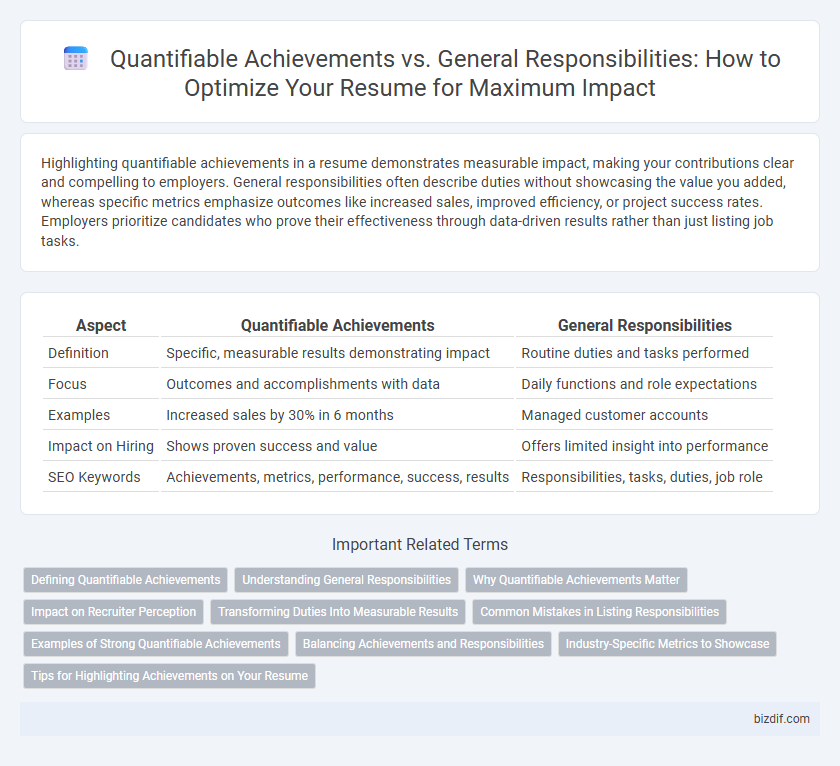Highlighting quantifiable achievements in a resume demonstrates measurable impact, making your contributions clear and compelling to employers. General responsibilities often describe duties without showcasing the value you added, whereas specific metrics emphasize outcomes like increased sales, improved efficiency, or project success rates. Employers prioritize candidates who prove their effectiveness through data-driven results rather than just listing job tasks.
Table of Comparison
| Aspect | Quantifiable Achievements | General Responsibilities |
|---|---|---|
| Definition | Specific, measurable results demonstrating impact | Routine duties and tasks performed |
| Focus | Outcomes and accomplishments with data | Daily functions and role expectations |
| Examples | Increased sales by 30% in 6 months | Managed customer accounts |
| Impact on Hiring | Shows proven success and value | Offers limited insight into performance |
| SEO Keywords | Achievements, metrics, performance, success, results | Responsibilities, tasks, duties, job role |
Defining Quantifiable Achievements
Defining quantifiable achievements in resume writing involves highlighting specific, measurable outcomes that demonstrate your impact, such as increasing sales by 20% or reducing customer complaints by 30%. These achievements provide concrete evidence of your contributions and value to past employers, setting you apart from generic job duties. Employers prioritize quantifiable results because they clearly show how your skills translate into real-world success.
Understanding General Responsibilities
Understanding general responsibilities on a resume highlights the candidate's routine tasks and role expectations, providing a baseline for job functions. These responsibilities outline the scope of the position and demonstrate familiarity with standard industry practices. Clear articulation of general responsibilities helps employers gauge the candidate's foundational skills before evaluating specific accomplishments.
Why Quantifiable Achievements Matter
Quantifiable achievements demonstrate measurable impact, providing concrete evidence of skills and contributions that general responsibilities lack. Recruiters prioritize resumes showcasing specific results, such as "increased sales by 30%" or "reduced processing time by 25%," as these metrics validate the candidate's effectiveness. Highlighting quantifiable achievements boosts credibility and distinguishes applicants in competitive job markets.
Impact on Recruiter Perception
Highlighting quantifiable achievements in a resume significantly enhances recruiter perception by providing concrete evidence of past performance, making candidates stand out from those listing only general responsibilities. Metrics such as percentage increases in sales, number of projects led, or cost savings demonstrate a candidate's direct impact and effectiveness. This data-driven approach helps recruiters quickly assess potential value and suitability for the role.
Transforming Duties Into Measurable Results
Quantifiable achievements in a resume demonstrate specific accomplishments by using data or metrics, such as increasing sales by 30% or reducing project completion time by 15%, which provides clear evidence of impact. Transforming general responsibilities into measurable results involves highlighting how tasks directly contributed to business goals or improvements, making your contributions tangible and compelling to employers. Emphasizing quantifiable outcomes rather than vague duties enhances credibility and strengthens a candidate's competitive edge in the job market.
Common Mistakes in Listing Responsibilities
Listing general responsibilities instead of quantifiable achievements can weaken a resume's impact by failing to demonstrate measurable value or results. Common mistakes include using vague phrases like "responsible for" without specifying outcomes or ignoring data such as percentage improvements, sales figures, or project completions. Focusing on specific metrics like "increased sales by 20%" or "reduced processing time by 30%" helps hiring managers clearly assess a candidate's contributions.
Examples of Strong Quantifiable Achievements
Including strong quantifiable achievements in a resume, such as "increased sales revenue by 30% within six months" or "reduced customer complaint resolution time from 48 to 24 hours," demonstrates tangible impact. Specific metrics like percentages, dollar amounts, or timeframes provide evidence of success and differentiate candidates from those listing vague responsibilities. Employers prioritize these measurable results to assess candidates' effectiveness and potential value to the organization.
Balancing Achievements and Responsibilities
Highlight quantifiable achievements by incorporating specific metrics such as percentage improvements, revenue growth, or project completion rates alongside general responsibilities to demonstrate impact effectively. Use precise numerical data like "increased sales by 25%" or "managed a team of 10" to balance concrete accomplishments with ongoing duties. This approach ensures a resume reflects both the scope of work and measurable results, optimizing recruiter engagement.
Industry-Specific Metrics to Showcase
Quantifiable achievements in resumes highlight measurable results such as a 20% increase in sales revenue or a 15% reduction in operational costs, which demonstrate tangible impact within a specific industry. Industry-specific metrics like customer retention rates for marketing roles or defect rates for manufacturing positions effectively showcase expertise and value to employers. Emphasizing these data-driven accomplishments over general responsibilities enhances credibility and aligns with hiring managers' expectations for performance evidence.
Tips for Highlighting Achievements on Your Resume
Focus on incorporating specific metrics such as percentage increases, revenue growth, or cost savings to clearly demonstrate your impact. Use action verbs paired with quantifiable results to create compelling bullet points that stand out to recruiters. Emphasize outcomes over duties by highlighting how your contributions directly benefited previous employers or projects.
Quantifiable Achievements vs General Responsibilities Infographic

 bizdif.com
bizdif.com